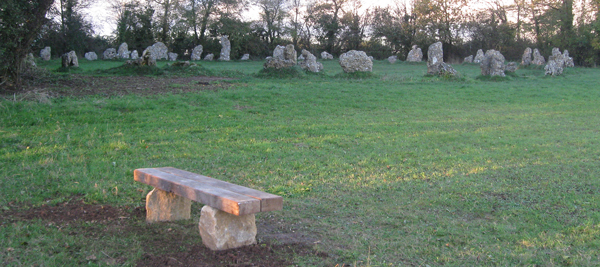It comes full circle...
4000 years ago, give or take a year or two, ancient Britons quarried large oolitic limestone blocks to produce the remarkable Rollright Stones. An ancient and mysterious site comprising of 77 large stones - we think, as legend has it that it is impossible to count the stones. Many have tried! It is said that - "The man will never live who shall count the stones three times and find the number the same each time." In complete contrast it is also said that "anyone who thrice counts the same number will have their heart’s desire fulfilled".
Even to this day it is genuinely difficult to count the Stones, and modern accounts seem to vary in the numbers they give, especially as it is not known exactly which of the Stones are original.
Enough of the devil, witches and faeries, they are after all just myths and legends…
A few years ago the guardian (or site manager if you wish) of the Rollright Stones sadly died. To commemorate Dohn Prout’s hard work and commitment to the Stones it was decided to have benches commissioned in his honour. The benches are now to be known as the ‘Dohn Benches’.

The construction of the benches, as you can see from the photographs are wooden seats and stone ‘legs’. These legs, kindly donated to the Trust, fittingly came from Smiths quarry just down the road - and again using the oolitic limestone which our forebearers had done.
The Rollright quarry is now known for the production of high quality cotswold dry walling stone, but it makes you think that ancient stones quarried locally by ancient Britons are being maintained and complemented by a modern quarry just around the corner.
Do visit the ancient site, sit on the new Dohn Benches, try and count the stones, if you dare. And look at the inscription on the benches, there is one which is not what it seems! What language is it written in? Look carefully… the answer is staring you in the face.

More information on The Rollright Stones can be found on their website www.rollrightstones.co.uk
Details of the Rollight quarry can be found by clicking here
GABION STONE ON TELEVISON...
Gabion stone, supplied by Smith & Sons, were used as a landscape feature on the popular Channel 4 programme Grand Design. This particular episode (two parts) is based in Swindon where Kevin McCloud sets out to do what Britain's housing industry said couldn't be done - to build beautiful, contemporary, affordable, sustainable homes and still make money. The gabion stone is used to create small corner walls - in effect to hide dustbins - in a otherwise open planned garden landscape. Take a look for yourself and see how a simple stone can be used a such a creative manner. Any thoughts and photographs of your creations would be welcomed. Channel 4
